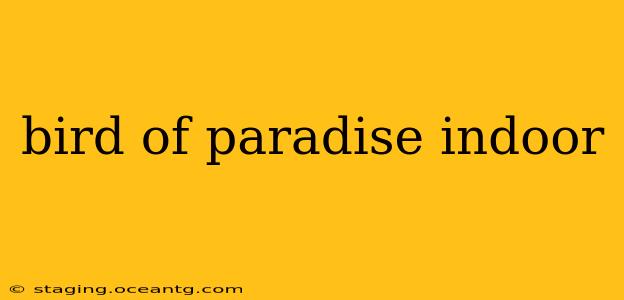The Bird of Paradise plant, with its vibrant, exotic flowers resembling a crane's head, is a coveted houseplant. However, successfully cultivating this beauty indoors requires understanding its specific needs. This comprehensive guide will cover everything from selecting the right plant to troubleshooting common problems, ensuring your Bird of Paradise thrives in your home.
What are the different types of Bird of Paradise plants suitable for indoor growing?
While there are several species of Strelitzia, two are most commonly grown indoors: Strelitzia reginae (the common Bird of Paradise) and Strelitzia juncea (the narrow-leaved Bird of Paradise). Strelitzia reginae is the more popular choice for its striking orange and blue flowers, though it requires more space. Strelitzia juncea, with its grass-like foliage, is a more compact option suitable for smaller spaces. Both require similar care, albeit with slight variations in watering needs based on their differing foliage.
How much sunlight does a Bird of Paradise plant need indoors?
Bird of Paradise plants need plenty of bright, indirect light. A south- or east-facing window is ideal, but avoid direct sunlight, which can scorch the leaves. If you only have a north-facing window, you may need to supplement with grow lights to ensure adequate light for flowering. The plant will thrive with at least 6 hours of bright, indirect light daily. Observe your plant; if leaves are pale or leggy, it's likely not getting enough light. Conversely, if the leaves are browning or crisping, it's receiving too much intense light.
How often should I water my indoor Bird of Paradise?
Watering your Bird of Paradise is crucial for its health. Allow the top inch or two of soil to dry out before watering thoroughly. Overwatering is a common problem that can lead to root rot. During winter months, reduce watering frequency. The best way to determine when to water is to check the soil moisture using your finger. If the soil feels dry, it's time to water. Aim for a consistent moisture level, preventing both soggy soil and complete dryness.
What type of soil is best for an indoor Bird of Paradise?
Well-draining soil is paramount for a Bird of Paradise plant. A potting mix specifically formulated for indoor plants, often containing perlite or vermiculite, is ideal. This ensures excess water can drain readily, preventing waterlogging that can damage the roots. You can also add some coarse sand to improve drainage in your regular potting mix.
How often should I fertilize my indoor Bird of Paradise?
Feed your Bird of Paradise during its active growing season (spring and summer) with a balanced liquid fertilizer diluted to half strength every 2-4 weeks. Reduce or cease fertilization during the fall and winter months when growth slows. Over-fertilizing can harm the plant, so follow the instructions on the fertilizer packaging carefully. Opt for a fertilizer formulated for flowering plants to encourage blooms.
How do I repot my indoor Bird of Paradise?
Repotting is usually necessary every 2-3 years or when the plant becomes root-bound. This is when the roots begin to circle the pot and impede growth. Choose a pot only slightly larger than the previous one. A terracotta pot is a good choice, as it allows for better airflow and prevents waterlogging. Handle the plant carefully to avoid damaging its roots during repotting. Use fresh potting mix.
What are common problems with growing Bird of Paradise indoors?
Common issues include yellowing leaves (often due to overwatering or underwatering), browning leaf tips (indicative of low humidity or salt buildup), and a lack of flowering (usually caused by insufficient light or inadequate fertilization). Addressing these issues promptly will keep your plant healthy and flourishing. Regularly inspect your plant for pests like mealybugs or spider mites, treating them immediately if discovered.
How can I propagate my Bird of Paradise?
Bird of Paradise plants can be propagated from seed or by division. Seed propagation is a lengthy process, often taking several years to flower. Division, separating off established clumps of the plant during repotting, is a more efficient method for propagating established plants.
By following these guidelines, you can cultivate a thriving and beautiful Bird of Paradise plant indoors. Remember, consistent care, attention to detail, and patience are key to success with this exotic beauty.
